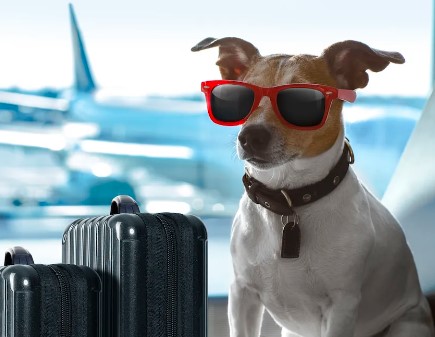Traveling with pets can be a rewarding experience, allowing you to create lasting memories with your furry companions. Whether you’re embarking on a road trip, flying to a new destination, or exploring the great outdoors, careful planning and preparation are essential to ensure a safe and enjoyable journey for both you and your pets. In this guide, we’ll explore tips and best practices for traveling with pets, covering everything from transportation and accommodations to health and safety considerations.

Choosing the Right Mode of Transportation
Road Trips
When traveling by car, ensure your pet is properly secured in a pet carrier, harness, or seatbelt restraint to prevent injury or distraction while driving. Make frequent stops to allow your pet to stretch their legs, hydrate, and relieve themselves. Never leave your pet unattended in a parked vehicle, especially in hot or cold weather, as temperatures can quickly become dangerous.
Air Travel
If flying with your pet, research airline policies and requirements regarding pet travel, including crate specifications, health documentation, and pet fees. Choose a pet-friendly airline and book a direct flight whenever possible to minimize stress and reduce travel time. Acclimate your pet to their travel crate or carrier beforehand to help them feel more comfortable during the journey.
Train or Bus
When traveling by train or bus, check with the transportation provider regarding their pet policies and any restrictions on pet size, breed, or carriage. Keep your pet confined to a carrier or crate and ensure they remain quiet and well-behaved to avoid disturbing other passengers. Bring along essential supplies such as food, water, and waste disposal bags to meet your pet’s needs during the journey.
Preparing for the Journey
Visit the Veterinarian
Before traveling, schedule a visit to the veterinarian for a health check-up and ensure your pet is up-to-date on vaccinations, parasite prevention, and any required travel documentation. Obtain a health certificate or pet passport if traveling internationally, and carry copies of your pet’s medical records and identification tags for identification in case of emergencies.
Pack Essentials
Pack a travel kit for your pet containing essentials such as food, water, bowls, medication, bedding, toys, and grooming supplies. Bring along familiar items from home, such as blankets or toys, to provide comfort and familiarity during the journey. Consider packing a first aid kit for pets containing supplies for treating minor injuries or illnesses.
Microchip Your Pet
Ensure your pet is microchipped and registered with up-to-date contact information before traveling. A microchip provides a permanent form of identification that can help reunite you with your pet if they become lost or separated during the journey. Additionally, attach a secure collar with identification tags containing your contact information to your pet’s collar as a backup form of identification.
On the Road: Tips for Safe and Comfortable Travel
Plan Pet-Friendly Stops
Research pet-friendly accommodations, restaurants, and attractions along your route and plan your itinerary accordingly. Look for hotels that welcome pets and offer amenities such as designated pet areas, walking trails, and pet-friendly dining options. When dining out, choose restaurants with outdoor seating or pet-friendly patios where your pet can join you.
Exercise and Rest Breaks
Make regular stops to allow your pet to stretch their legs, exercise, and relieve themselves. Look for rest areas, parks, or designated pet areas where your pet can safely explore and stretch their legs. Provide access to fresh water and offer small meals or treats to keep your pet hydrated and nourished during the journey.
Monitor Your Pet’s Comfort
Pay attention to your pet’s behavior and comfort level during the journey, and make adjustments as needed to ensure their well-being. Watch for signs of stress, anxiety, or discomfort, such as panting, pacing, or whining, and provide reassurance and comfort as needed. Consider using calming aids such as pheromone sprays or calming supplements to help reduce travel-related anxiety.
Flying with Pets: Tips for a Smooth Journey
Choose the Right Carrier
Select a sturdy and well-ventilated pet carrier or crate that meets airline requirements for size, strength, and ventilation. Introduce your pet to their travel crate gradually and allow them to become familiar with it before the journey. Line the crate with absorbent bedding and provide familiar items such as toys or blankets to help your pet feel more comfortable during the flight.
Prepare for Security Screening
Be prepared to remove your pet from their carrier during security screening and follow instructions from airport staff regarding the screening process. Carry any required documentation, including health certificates, vaccination records, and pet passports, in a secure and easily accessible location. Keep your pet calm and under control during the screening process to minimize stress for both you and your pet.
Plan for Layovers and Connections
If your flight includes layovers or connections, research pet relief areas and facilities available at each airport along your route. Allow ample time between flights to give your pet a chance to stretch their legs, use the restroom, and rehydrate before continuing the journey. Keep your pet’s travel documents and identification tags on hand during layovers for easy access if needed.
International Travel with Pets: Additional Considerations
Research Import Requirements
When traveling internationally with your pet, research import requirements and regulations for your destination country well in advance of your trip. Obtain any required vaccinations, health certificates, or import permits as specified by the destination country’s authorities. Allow sufficient time for processing and approval of travel documents to avoid delays or complications.
Quarantine and Quarantine
Be aware of quarantine and quarantine requirements that may apply when traveling internationally with your pet. Some countries require pets to undergo quarantine upon arrival to prevent the spread of infectious diseases. Familiarize yourself with quarantine procedures and regulations for your destination country and ensure your pet meets all requirements for entry.
Plan for Adjustments
Prepare your pet for the challenges of international travel, including changes in climate, time zone, and environment. Gradually acclimate your pet to their travel crate or carrier and practice travel routines to help them feel more comfortable and relaxed during the journey. Bring along familiar items from home, such as bedding or toys, to provide comfort and reassurance in unfamiliar surroundings.
Conclusion
Traveling with pets can be a rewarding and enriching experience, allowing you to create cherished memories and strengthen the bond with your furry companions. By following these tips and best practices, you can ensure a safe, comfortable, and enjoyable journey for both you and your pets. Whether embarking on a road trip, flying to a new destination, or exploring the great outdoors, careful planning and preparation are key to a successful travel experience with pets. With proper planning and attention to your pet’s needs, you can make every adventure a memorable and fulfilling experience for both you and your furry companions.

